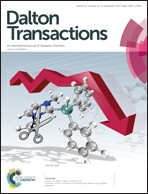A magnetically isolated cuprate spin-ladder system: synthesis, structures, and magnetic properties†
Abstract
We synthesized and characterized two magnetically isolated spin ladders, Cu2(CO3)(ClO4)2(NH3)6 (1) and Cu2(CO3)(ClO4)2(H2O)(NH3)5 (2), which are the first examples of carbonate bridging molecular spin ladders. Compounds 1 and 2 form a ladder configuration by stacking a structural unit composed of two Cu2+ ions and one CO32−, where the Cu–O–Cu interactions form the rungs and legs of each ladder and the counter anions (ClO4−) occupy the space between the ladders and ensure their magnetic isolation. A S = 1/2 magnetically isolated spin-ladder model with a ladder-rung magnetic interaction J1/kB = 364 K (where J is defined as positive for antiferromagnetic interactions) and a ladder-leg magnetic interaction J2/kB = 27.4 K accurately predicts the temperature dependence of the molar magnetic susceptibility for 1. The ladder configuration of 2 is similar to that of 1 except that the CO32− is alternately skewed in different directions in the stacked structural unit. Interestingly, this minor structural variation in 2 results in its remarkably different magnetic behavior; the magnetic susceptibility curve of 2 is accurately described by an alternating chain model with J3/kB = 7.26 K and J4/kB = 4.42 K.


 Please wait while we load your content...
Please wait while we load your content...